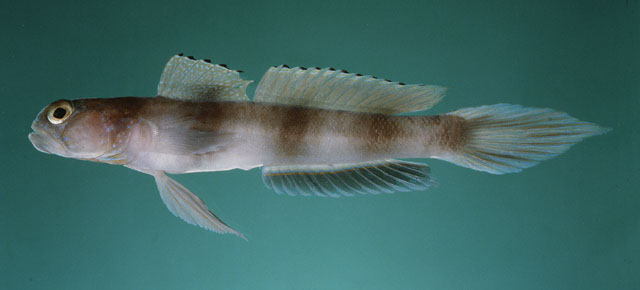Amblyeleotris biguttata Randall, 2004
Description
Dorsal spines (total): 7; Dorsal soft rays (total): 13; Anal spines: 1; Anal soft rays: 13; Vertebrae: 25. Diagnosis: Dorsal rays VI+I, 13; anal rays I, 13; pectoral rays 19; pelvic fins joined by membrane to tips of fifth rays; pelvic frenum present; fourth pelvic ray longest; fifth pelvic ray branching twice. Longitudinal scale series 91-103; no median predorsal scales; scales on side of nape extending to above middle of opercle. Gill opening reaching forward to a vertical about two-thirds orbit diameter behind eye. Body depth 5.8-6.1 in SL; head length 3.6-3.8 in SL; caudal fin pointed and long, 2.2-2.6 in SL. Pale brown dorsally, white ventrally, with three indistinct brown bars on body, and a slightly oblique brown bar from nape across opercle; pale interspaces with small brown blotches, faintly interconnected; a pair of prominent black spots on chin; dorsal fins yellowish grey, the first dorsal with small irregular dark-edged pale blue spots and orange tipped spines, the second dorsal with a broad yellow border containing small dark-edged pale blue spots, the rays tipped with orange; caudal fin with a vertically elongate diffuse brown spot on base (Ref. 57552).
Taxonomic Hierarchy
Kingdom: Animalia
Phylum: Chordata
Class: Teleostei
Order: Gobiiformes
Family: Gobiidae
Genus: Amblyeleotris
Species: Amblyeleotris biguttata Randall, 2004
Climate Zone
Location
Biology
The species inhabits silty sand areas and is associated with unidentified alpheid shrimp, where this species takes refuge in the shrimp's burrow (Ref. 57552).
Habitat
demersal


